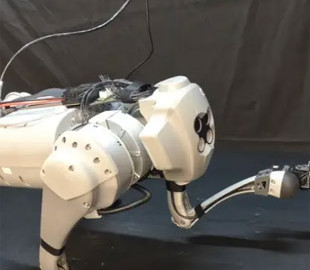Inexpensive devices that engineers have called “loco-manipulators” turn the familiar robodog into a nimble machine that can simultaneously walk and interact with objects.
What are its capabilities
Four-legged robots usually take the form of robot dogs, including Boston Dynamics' Spot. They can move quickly over difficult terrain and usually have a low center of gravity. Most quadrupedal object-manipulating robots have two extra arms that can lift and carry objects, giving them a total of six limbs.
But LocoMan is unique in that it can transition from a four-legged position to a standing position and use two front legs to manipulate objects.
We present LocoMan, a novel approach that improves the manipulative dexterity of quadruped robots by integrating engineered lightweight loco-manipulators, expanding their workspace and providing precise control over complex 6D manipulation tasks, – the scientists wrote.
The key point here is that the ability to manipulate objects was designed without compromising LocoMan's maneuverability.
However, its multi-functional legs have also demonstrated versatility in challenging environments such as confined spaces and rocky terrain. The robot demonstrated precise and stable movements during tasks that required “complex two-hand coordination.” This sets LocoMan apart from other four-legged robots.
Its design was inspired by the “anatomy of the human hand” with custom-made loco-manipulators that use joints added to the calf area of the front legs. These leg joints are similar to human elbow and shoulder joints. They include four compact actuators (motion control components) that provide position, velocity and torque feedback.
To make the loco-manipulators more compact, the team designed the gripper in the form of two pairs of rotating jaws with toothed meshing, which allows symmetrical opening and closing of the gripper with the help of a single motor.
To seamlessly integrate the loco-manipulator into the existing structure of the quadruped work, the joints had to be aligned and allow movement and grip, while neither of these possibilities had to interfere with the other.
Testing
Researchers evaluated LocoMan using real-world experiments, such as opening doors, inserting plugs into electrical outlets, and picking up objects in tight spaces. The team noted in the study that the robot completed all tasks and showed “remarkable dexterity”.
Our study offers a different perspective on intelligent robots. Instead of copying humans with similar morphology, we would like to create a complementary robot that can do things that a human might not want to do,
– said Ding Zhao, associate professor of mechanical engineering at Cornell University.
Now scientists want to test LocoMan in more complex real-world conditions and situations. In the future, they also plan to add computer vision and machine learning algorithms to the robot in their research.
LocoMan Robot Demonstration: Video
< iframe width="560" height="314" src="//www.youtube.com/embed/d-GLiRPiHIE" allowfullscreen="allowfullscreen">

